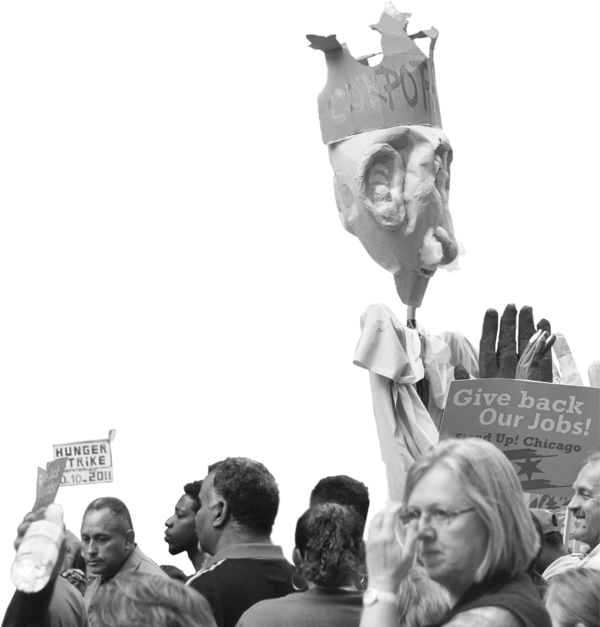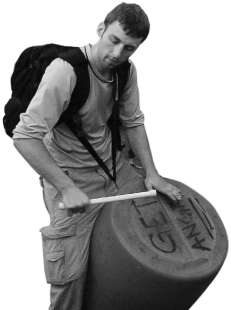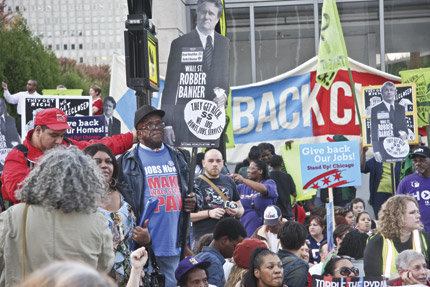
“People are pissed as hell because there is an unjust paradigm in this country where the wealth accumulates at the top and the bottom is forgotten,” said a young man at the Federal Reserve Bank on September 29. He was one of about ten protesting on the sixth day of Occupy Chicago, a movement that erupted Friday September 23 as a response to the larger occupation of Wall Street in New York City. “It started with four, grew to double digits, at least fifty over the weekend. … We’ll stay as long as possible, as long as we can, in solidarity with Occupations that have started up in dozens of cities countrywide and nationwide,” he said.
Since that day, the movement has only grown; similar occupations, inspired by New York City’s Occupy Wall Street, have sprung up in over 100 U.S. cities and internationally from London to Australia. Occupy Chicago’s numbers fluctuate as people come to and from work, school or their families, but the numbers have grown from 35 to upwards of 2000. At any given hour at the Federal Reserve Bank you may find anywhere from 5 to 250 or more people playing drums and chanting slogans like: “The people united will never be defeated!” “Banks got bailed out, we got sold out!”and the most famous one, “We are the 99%.”

While the movement represents a diverse range of ages, in Chicago it has a specifically youthful character. Among the protesters, many conversations can be overheard about overwhelming college debt, the lack of job opportunities, the trials and tribulations broke and overqualified graduates face as they fight for low-paying jobs. What started September 17 in Manhattan’s Financial District has become a movement of unprecedented proportions. The successful revolutions of Egypt and Tunisia are often cited as inspiration for the movement: two events that proved the power of mass protests to affect large scale change. Taking a cue from the Middle East, the Occupy movements have relied heavily on the use of social media to network and livestream.
The national movement has been heavily criticized for its lack of concrete demands. While no official requests have been created, the general assembly meetings in Chicago often center on how to streamline the movement and what its biggest issues really are. The philosopher and critical theorist Slavoj Žižek wrote about the European protesters in the London Review of Books, “We’ve entered a post-ideological era where opposition to the system can no longer articulate itself in the form of a realistic alternative, or even as a utopian project, but can only take the shape of a meaningless outburst.”
On the other hand, Bernard E. Harcourt, chair of the political science department and professor of law at The Univesity of Chicago, responded to Žižek in the opinion section of the New York Times, saying, “He failed to understand that these movements are precisely about resisting the old ideologies. It’s not that they couldn’t articulate them; it’s that they are actively resisting them. They are being politically disobedient.” He distinguishes political disobedience from civil disobedience, arguing that the first “fundamentally rejects the political and ideological landscape that we inherited from the Cold War.”

The group remains determined to remain a “leaderless, people-powered movement” that uses “open, participatory and horizontal organizing,” as Adbusters described Occupy Wall Street.
The ultimate reason for the political uprising is the economic inequality the country is facing. Harcourt cites sociologist Douglas Massey’s book, “Categorically Unequal,” saying that “after decades of improvement, the income gap between the richest and poorest in this country has dramatically widened since the 1970s, resulting in what social scientists now refer to as the “U-curve of increasing inequality.” He cites as well recent reports from the Census Bureau that confirm it. “The number of Americans living below the official poverty line, 46.2 million people, was the highest number in the 52 years the Bureau has been publishing it,” the reports inform. According to Harcourt, “27 percent of African-Americans and 26 percent of Hispanics in the country – more than 1 in 4 – live in poverty; and 1 in 9 African-American men between the ages of 20 and 34 are incarcerated.”







